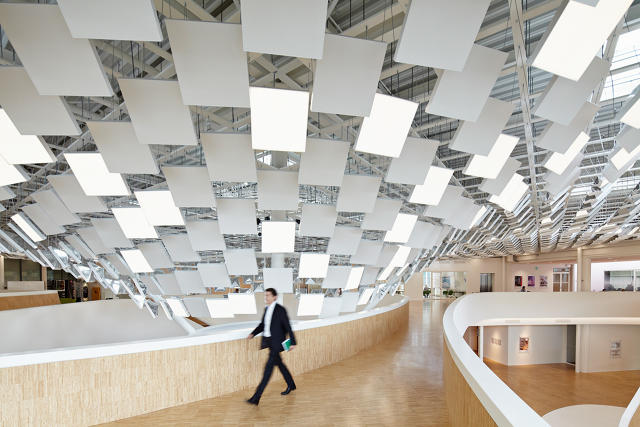The designers at Philips Lighting, maker of the multi-colored Hue smart bulbs among other glowing and shining products, know that there's a link between productivity, happiness, and workplace lighting. So when it came to updating their vintage corporate headquarters in Eindhoven, they wanted to practice what they preached. Philips teamed up with Lava Architects and Beersnielsen to cover the building's stark, lifeless atrium with a canopy of beautiful opaque panels, spreading light like sunshine scattering between leaves.
When the Philips Lighting headquarters was originally built in the 1950s, it was made up of a number of separate buildings, surrounding a large outdoor courtyard. At some point, the company decided to consolidate these buildings into one mega-structure by covering the courtyard with an enormous, 115,000 square foot ceiling, which let in sunlight through a scattering of skylights. But for a lighting company like Philips, the result was dreary—and it was an acoustic nightmare.

"When we started discussing how to redesign our headquarters back in 2011, we came pretty quickly to the idea that we had to break up this space [for both lighting and acoustic reasons]," explains Pierre-Yves Panis, chief designer at Philips Lighting. But the designers found that prospect exciting. The covered atrium, Panis says, was "literally a blank piece of paper" that they could use to demonstrate everything they knew about the importance of great lighting in an office workspace... especially the notion that more naturalistic lighting can help amp up creativity and collaboration, thanks to the way cortisol levels drop under artificial or poor lighting conditions.
One important design consideration of the canopy was that it needed to "have a life of its own," says Panis. In other words, it needed to improve the atrium's natural lighting, even when the power was turned off. To create this effect, Philips combined of over 1,500 separate panels, overlaying them slightly upon one another like leaves in a forest canopy. These actually aren't lights at all: They instead serve to diffuse a smaller bank of LED lights, as well as let natural light peek through the skylights above. It creates a leaf-like ripple effect, thanks to the fact that each panel is backed by an irregular reflective pyramid, which bends and bounces the light around in interesting ways.

And that's just when the canopy is turned off. When it's illuminated, 500 Philips Ecophon Soundlight Comfort panels kick in, algorithmically blinking on and off according to parameters like the time of day, the season of the year, and how many people are in the building. No more than 60% of the panels are ever illuminated at a given time, which gives the light patterns a soothing and whimsical dancing effect, which is further enhanced by 50 Philips Selecon RAMA LED fixtures that are placed in the middle of the space, creating a golden light that resembles sunshine sparkling on water at sundown.
Asked how he would describe sitting under the Canopy to people who'd never seen it, Panis says: "There's this impression of constant movement that never makes you uncomfortable," he says. "The light has a natural ebb and flow, like the tide coming in and out. But what's beautiful about it is it's not really like anything else. It's difficult to describe in words, because when you see it, it describes itself."